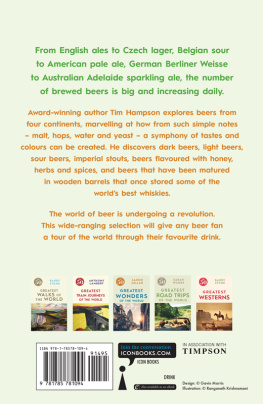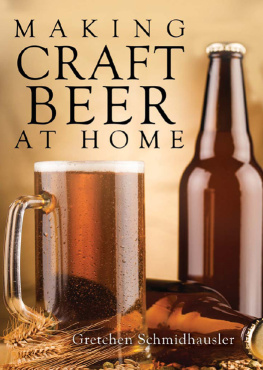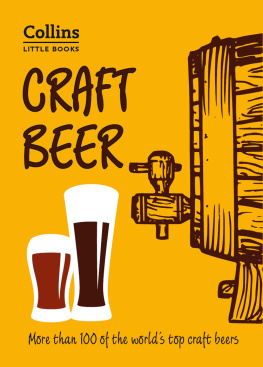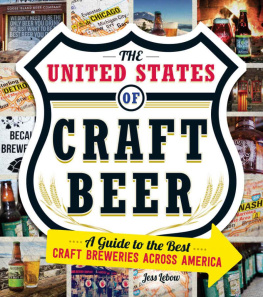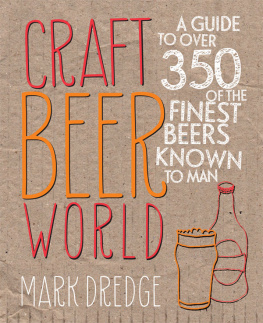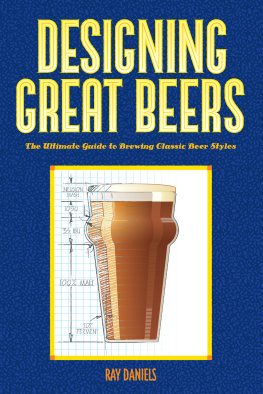

For Tara. For your support and eternal patience.

CONTENTS

Beer in Australia:
An Introduction
If you are a 20-year-old in Australia today who enjoys drinking the occasional tasty beer, you may well wonder what all the fuss is about. You may question why many people older than you become so passionate when the subject of beer is raised, their passion manifested by an unstoppable desire to convert people to craft beer or by the manner in which they decry the actions and products of the countrys two dominant, foreign-owned brewing companies with the sort of language usually reserved for deviants and war criminals.
You may question why people who have long outgrown their band T-shirts have a collection of clothing that is adorned with cartoon hop flowers and the names of breweries from all over the world. After all, you dont see wine aficionados sauntering the countrys wine regions with the names and logos of their favourite biodynamic winery emblazoned across their chests.
You may ask these questions, and more, with good reason.
Whats the big deal? you might ask. I can get Little Creatures IPA, Stone & Wood Pacific Ale and Mountain Goat at my local Liquorland. What on earth are you getting so worked up about?
The simple answer is this: if you are a 20-year-old in Australia today who enjoys drinking the occasional tasty beer, youre bloody lucky.
At the risk of sounding like an octogenarian bemoaning their great-grandchilds decision not to vote, a lot of people sacrificed a heck of a lot to get even that small selection of beers into the countrys largest retail chains. Okay, so no one had to die (though some of Australias craft beer pioneers didnt live long enough to see the industry approach critical mass) but the struggle to brew, then sell and, ultimately, popularise anything that wasnt 5 per cent pale lager beer has been arduous. The growth of the microbrewery industry in the past five years has been so rapid that newcomers, and indeed most in the media, might feel it is an overnight success. Like most overnight successes, however, it has been a long time in the making.
Go back just five years and you will find plenty even within the beer industry who questioned whether craft beers upward trajectory was sustainable or whether it would prove a flash in the pan. Go back 20 years and the number of breweries in Australia was barely in double figures; today there are more than 200 breweries and brewing companies. Go back just over 30 years and, with the exception of Coopers and a handful of old-school stouts, beer culture in Australia was a monoculture: one beer brewed by a handful of powerful state-based breweries, consumed by male drinkers loyal to their local brands and those of their dads and their dads before them.
THE ORIGINAL CRAFT BEERS
Yet it was not always this way. Back in the early days of the colonies, breweries were local and brewed a range of beers, such as English-inspired ales, porters and stouts. The stories of the countrys first two acknowledged brewers, James Squire and, to a lesser extent, John Boston, have been retold via contemporary brands that bear their names but, as settlers spread across Australia, breweries sprung up with them. The standard of their output may have been variable brewers may have particularly struggled in the heat of summer due to a lack of refrigeration but these small breweries, without distribution networks, would serve a handful of local outlets and offer a variety of beers.
With these local beers available alongside ales imported from England, Australian drinkers through much of the nineteenth century had a reasonable choice of tipples. Towards the end of the nineteenth century there were around 300 breweries in Australia at a time when the population was still fewer than four million.
Change was coming, however, with its genesis towards the end of that century. Some of the larger, city-based breweries had begun establishing tied houses: pubs that they owned and that would only serve their beer, a tactic that gave them an advantage over many smaller, suburban and regional breweries. These challenges were exacerbated by the economic depression of the 1890s, during which many breweries closed.
It wasnt purely economics that threatened the existence of many smaller breweries, either. Drinking habits were to change, too. Gambrinus, a brewer from Germany, set up shop in Melbourne in 1885 and started brewing the countrys first lager, bringing with them the means of refrigeration that allowed them to serve their beers chilled. Two years later, the American Foster brothers followed suit, with Castlemaine opening in Brisbane before the decade was out. As these breweries grew, the popularity of ice-cold, pale lagers ideally suited to the hot Australian climate took off.
The passing of the Commonwealth Beer Excise Act in 1901, which imposed heavy penalties on brewers who failed to meet its regulations, posed another threat to smaller breweries and led to further closures. While they shut their doors, the larger breweries with better technology, distribution networks and, ultimately, greater economies of scale, expanded rapidly. The shrinking of the industry was dramatic. According to The Breweries of Australia, by 1910 there were 157 breweries operating in Australia; a decade later that number had dwindled to just 77.
BEERS PEAK AND NADIR
Fast forward to the 1970s again, and rationalisation had reached its peak or nadir, depending on which side of the fence you sit. Beer consumption was at its highest level in Australian history and beer had the greatest share of the total alcohol market in the country. But punters were drinking that one beer, and they were drinking it in pubs that were generally rough, poorly maintained and purely the preserve of men. (Sure, there would be a room somewhere for the ladies to knit and sip Stones Ginger Wine, but the front bar was for blokes. Should a woman venture in and assert her right to remain, she faced arrest.)
The industry was dominated by a handful of large breweries that serviced their home states, the likes of Castlemaine Perkins, CUB, Tooheys, Swan and the South Australian Brewing Company, each of whom focused predominantly on brewing one style of beer consistently and efficiently.
Imported beer was practically non-existent, certainly outside a handful of traditional Irish pubs and the Lowenbrau Keller in The Rocks. Towards the end of the 1960s, even the previously ale-only Coopers Brewery in South Australia had released its first lager in more than a century of unbroken brewing.
Beer was nothing more than a fast-moving consumer good, and any discussion about quality or flavour was secondary, says Phil Sexton, one of the pioneers of Australias craft-brewing renaissance, of the period.
Australia was not alone in experiencing this change. Globally, large, efficient brewers of pilsner-style beers dominated. And if anyone had wanted to set up a smaller brewery they would have struggled. In Australia, when the major breweries upgraded their equipment, the redundant gear was destroyed to ensure there was no secondary market. And no manufacturer of brewing equipment anywhere in the world built anything suitable for a microbrewery setup.
Next page






